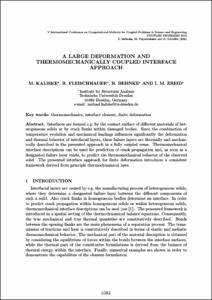A large deformation and thermomechanically coupled interface approach

Visualitza/Obre
Estadístiques de LA Referencia / Recolecta
Inclou dades d'ús des de 2022
Cita com:
hdl:2117/192691
Tipus de documentText en actes de congrés
Data publicació2013
EditorCIMNE
Condicions d'accésAccés obert
Tots els drets reservats. Aquesta obra està protegida pels drets de propietat intel·lectual i
industrial corresponents. Sense perjudici de les exempcions legals existents, queda prohibida la seva
reproducció, distribució, comunicació pública o transformació sense l'autorització del titular dels drets
Abstract
Interfaces are formed e.g. by the contact surface of different materials of heterogeneous
solids or by crack flanks within damaged bodies. Since the combination of
temperature evolution and mechanical loadings influences significantly the deformation
and thermal behavior of interfacial layers, these failure layers are thermally and mechanically
described in the presented approach in a fully coupled sense. Thermomechanical
interface descriptions can be used for prediction of crack propagation and, as soon as a
designated failure layer exists, to predict the thermomechanical behavior of the observed
solid. The presented interface approach for finite deformation introduces a consistent
framework derived from principle thermodynamical laws.
ISBN978-84-941407-6-1
| Fitxers | Descripció | Mida | Format | Visualitza |
|---|---|---|---|---|
| Coupled-2013-97_A large deformation and.pdf | 590,1Kb | Visualitza/Obre |

